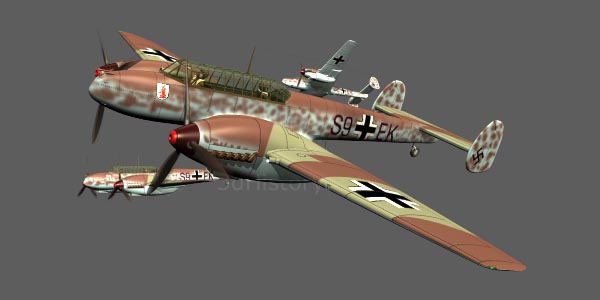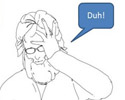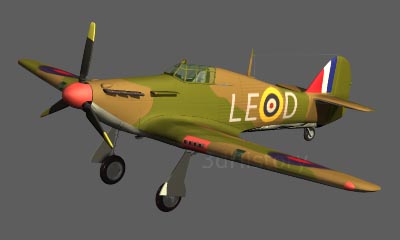The Second World War - Battle Of Britain - World War Two - War Machines
Battle of Britain
The Battle of Britain was the term used by Winston Churchill to describe the contest for air superiority between the RAF and Luftwaffe over the skies of Britain during late 1940.
With France out of the war the German military turned its attention to Britain. .
After the virtual destruction of the British Expeditionary Force at Dunkirk the only thing preventing the Germans from occupying Britain was the English Channel, and in order to cross it Germany had to secure air superiority over the South East coast of Britain.
In July 1940 the Luftwaffe had around 2600 bombers and fighters based in Norway, Holland, Belgium and France.

The main German medium bomber of the time was the Heinkel He111. It was developed in the early 1930’s as a transport aircraft to avoid the limitations of the Treaty of Versailles. The maximum speed was 440 km/h and it was capable of carrying 2,000 kgs of bombs over 2,000 kilometres. It was employed very successfully during the Battle for France but proved to be at a distinct disadvantage when faced with opposition such as Spitfire and Hurricane fighters.
The Royal Air Force could replace it's destroyed aircraft relatively easily but suffered from a shortage of pilots. However, unlike the Luftwaffe, many pilots that had been forced to abandon their aircraft could return to duty after bailing out over friendly territory.
Ground defences included radar, batteries of anti-aircraft guns, search lights and barrage balloons.
|
The Bofors 40 mm AA gun was based on a Swedish design. It was a reliable weapon that was used extensively by the Allies during World War Two. It could fire 40 mm shells to a height of around 6,000 to 12,000 metres at a rate of 120 to 330 shells per minute. |
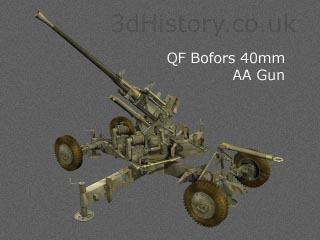
|
The German campaign began in July 1940 with attacks on shipping in the English Channel. It developed with massed attacks on RAF airfields during August and attacks on London and other cities during September. Finally, due to heavy losses, the Luftwaffe switched to night attacks, especially on London, which became famously known as 'The Blitz'.
During the Battle of Britain the Spitfire and its stable mate, the Hawker Hurricane, were responsible for opposing the fighters and bombers of the German Luftwaffe. After the Battle of Britain the Spitfire became the mainstay of Britain's fighter force and continued in development throughout the war.
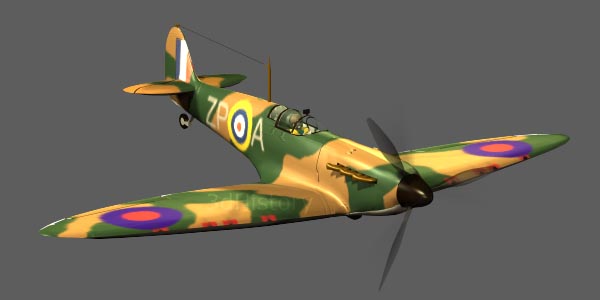
The Spitfire was developed from experience gained building R.J. Mitchell's Schneider Trophy winning seaplane designs. It's elliptical wing made it a very manoeuvrable aircraft, which gave it a distinct advantage during dogfights. This was slightly offset by a tendency for the Rolls Royce Merlin engine to loose power when subject to negative 'G' forces because the fuel was gravity fed.
|
The Hurricane was the most numerous fighter aircraft available to the RAF during the Battle of Britain and it accounted for more kills than the Spitfire. It wasn't as manoeuvrable or as fast as the Spitfire but still proved to be a very valuable asset due to its ability to sustain heavy damage. |
The main German fighter was the modern Messerschmitt bf109/E. Many of the best Luftwaffe pilots had seen action in the Spanish Civil War. They used this invaluable experience to develop tactics to suit the new high-speed aircraft.
The bf109 was designed by Willy
Messerschmitt in response to a
specification for a new fighter issued in
1934.
It utilised advanced design features for
the day having a stressed monocoque
body similar to a modern car, a fuel
injected V12 engine, an enclosed cockpit
and retractable undercarriage.
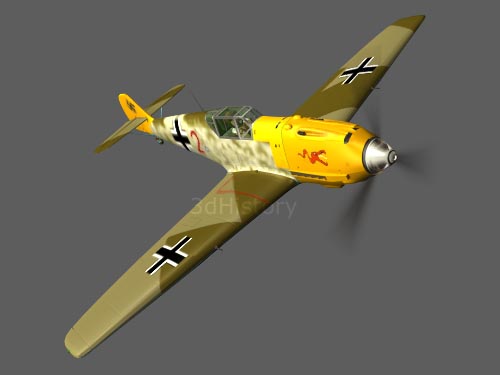
The German fighters had only sufficient fuel for a few minutes combat over England.
The RAF used Radar to identify German bomber streams and guide aircraft to intercept them, which meant that the RAF didn't have to maintain constant patrols, reducing wear and tear on both pilots and aircraft.
The Messerschmitt bf110 was designed as a heavy
long range fighter that could
preceded the bomber formations
and clear the way.
During the Battle of Britain it was
hopelessly outclassed by smaller,
faster Spitfires and Hurricanes.
Later successful adaptations
included night fighter variants
fitted with radar.
